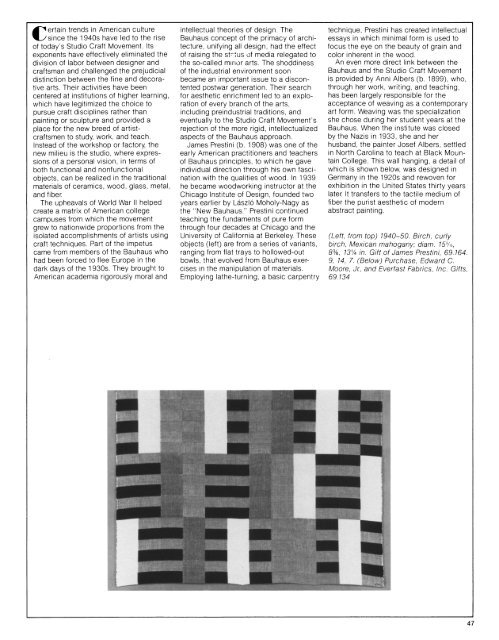r - The Metropolitan Museum of Art
r - The Metropolitan Museum of Art
r - The Metropolitan Museum of Art
Create successful ePaper yourself
Turn your PDF publications into a flip-book with our unique Google optimized e-Paper software.
Certain trends in American culture<br />
since the 1940s have led to the rise<br />
<strong>of</strong> today's Studio Craft Movement. Its<br />
exponents have effectively eliminated the<br />
division <strong>of</strong> labor between designer and<br />
craftsman and challenged the prejudicial<br />
distinction between the fine and decorative<br />
arts. <strong>The</strong>ir activities have been<br />
centered at institutions <strong>of</strong> higher learning,<br />
which have legitimized the choice to<br />
pursue craft disciplines rather than<br />
painting or sculpture and provided a<br />
place for the new breed <strong>of</strong> artistcraftsmen<br />
to study, work, and teach.<br />
Instead <strong>of</strong> the workshop or factory, the<br />
new milieu is the studio, where expressions<br />
<strong>of</strong> a personal vision, in terms <strong>of</strong><br />
both functional and nonfunctional<br />
objects, can be realized in the traditional<br />
materials <strong>of</strong> ceramics, wood, glass, metal,<br />
and fiber.<br />
<strong>The</strong> upheavals <strong>of</strong> World War II helped<br />
create a matrix <strong>of</strong> American college<br />
campuses from which the movement<br />
grew to nationwide proportions from the<br />
isolated accomplishments <strong>of</strong> artists using<br />
craft techniques. Part <strong>of</strong> the impetus<br />
came from members <strong>of</strong> the Bauhaus who<br />
had been forced to flee Europe in the<br />
dark days <strong>of</strong> the 1930s. <strong>The</strong>y brought to<br />
American academia rigorously moral and<br />
intellectual theories <strong>of</strong> design. <strong>The</strong><br />
Bauhaus concept <strong>of</strong> the primacy <strong>of</strong> architecture,<br />
unifying all design, had the effect<br />
<strong>of</strong> raising the status <strong>of</strong> media relegated to<br />
the so-called minor arts. <strong>The</strong> shoddiness<br />
<strong>of</strong> the industrial environment soon<br />
became an important issue to a discontented<br />
postwar generation. <strong>The</strong>ir search<br />
for aesthetic enrichment led to an exploration<br />
<strong>of</strong> every branch <strong>of</strong> the arts,<br />
including preindustrial traditions, and<br />
eventually to the Studio Craft Movement's<br />
rejection <strong>of</strong> the more rigid, intellectualized<br />
aspects <strong>of</strong> the Bauhaus approach.<br />
James Prestini (b. 1908) was one <strong>of</strong> the<br />
early American practitioners and teachers<br />
<strong>of</strong> Bauhaus principles, to which he gave<br />
individual direction through his own fascination<br />
with the qualities <strong>of</strong> wood. In 1939<br />
he became woodworking instructor at the<br />
Chicago Institute <strong>of</strong> Design, founded two<br />
years earlier by Laszlo Moholy-Nagy as<br />
the "New Bauhaus." Prestini continued<br />
teaching the fundaments <strong>of</strong> pure form<br />
through four decades at Chicago and the<br />
University <strong>of</strong> Californi at Berkeley <strong>The</strong>se<br />
objects (left) are from a series <strong>of</strong> variants,<br />
ranging from flat trays to hollowed-out<br />
bowls, that evolved from Bauhaus exer-<br />
cises in the manipulation <strong>of</strong> materials.<br />
Employing lathe-turning, a basic carpentry<br />
technique, Prestini has created intellectual<br />
essays in which minimal form is used to<br />
focus the eye on the beauty <strong>of</strong> grain and<br />
color inherent in the wood.<br />
An even more direct link between the<br />
Bauhaus and the Studio Craft Movement<br />
is provided by Anni Albers (b. 1899), who,<br />
through her work, writing, and teaching,<br />
has been largely responsible for the<br />
acceptance <strong>of</strong> weaving as a contemporary<br />
art form. Weaving was the specialization<br />
she chose during her student years at the<br />
Bauhaus. When the institute was closed<br />
by the Nazis in 1933, she and her<br />
husband, the painter Josef Albers, settled<br />
in North Carolina to teach at Black Mountain<br />
College. This wall hanging, a detail <strong>of</strong><br />
which is shown below, was designed in<br />
Germany in the 1920s and rewoven for<br />
exhibition in the United States thirty years<br />
later It transfers to the tactile medium <strong>of</strong><br />
fiber the purist aesthetic <strong>of</strong> modern<br />
abstract painting.<br />
(Left, from top) 1940-50. Birch, curly<br />
birch, Mexican mahogany, diam. 159/16,<br />
8%, 1314 in. Gift <strong>of</strong> James Prestini, 69.164.<br />
9, 14, 7. (Below) Purchase, Edward C.<br />
Moore, Jr, and Everfast Fabrics, Inc. Gifts,<br />
69.134<br />
47

















